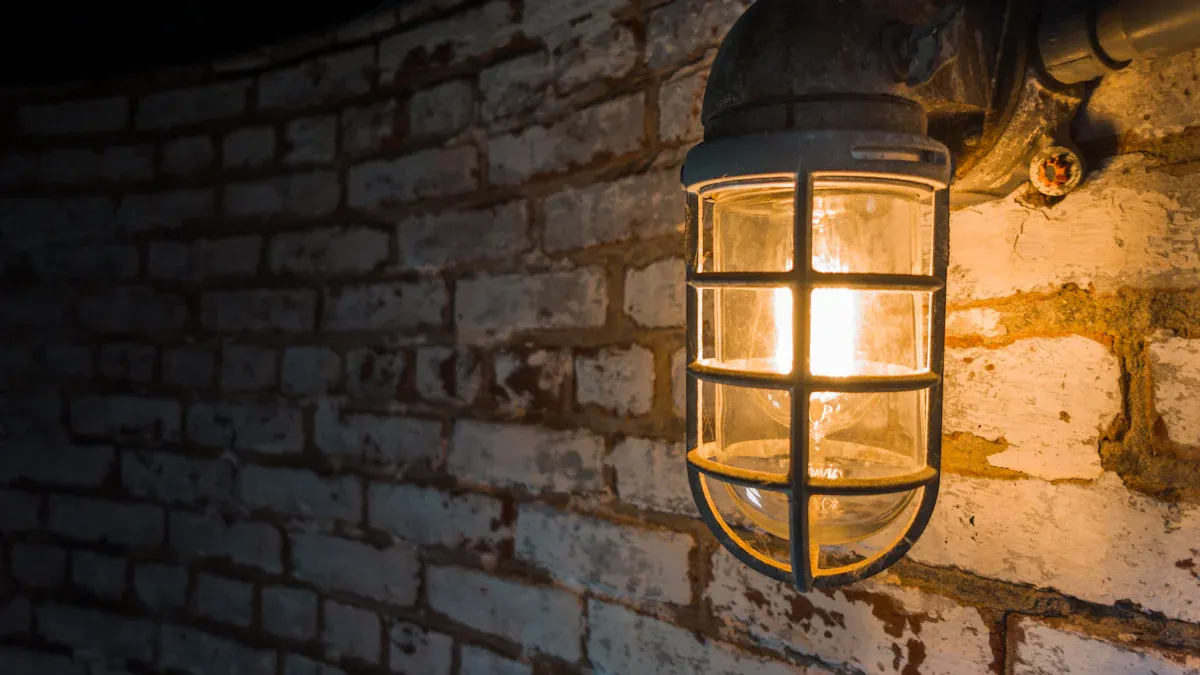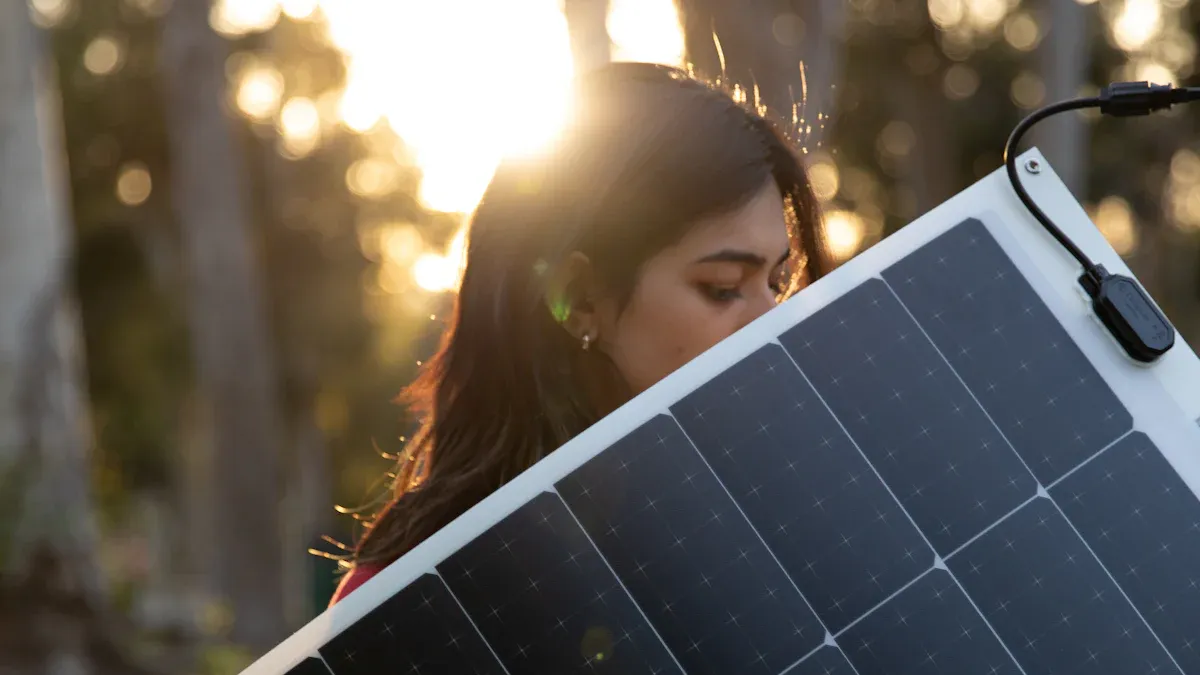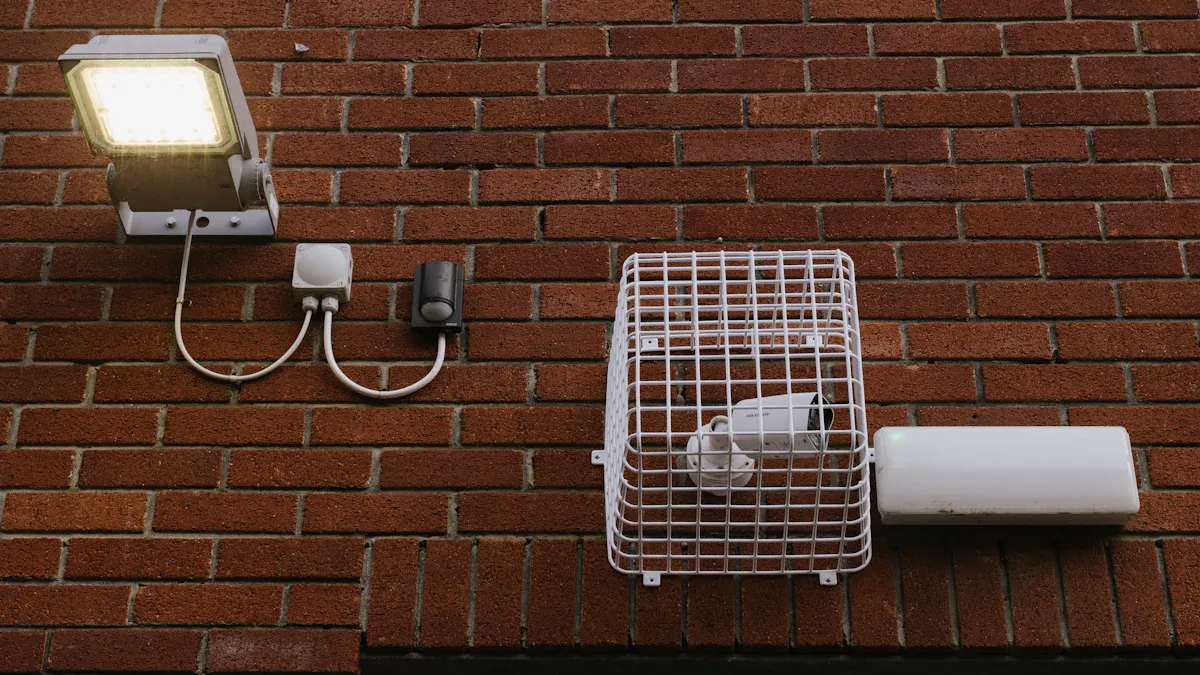- All
- Product Name
- Product Keyword
- Product Model
- Product Summary
- Product Description
- Multi Field Search
Views: 0 Author: Site Editor Publish Time: 2025-10-22 Origin: Site









Ever tried to install solar lights on a brick wall and felt stuck? I know that many people worry about damaging their outdoor lights or the brick itself. The best way to attach lights to brick is by using a drill with the right anchors, but I’ve also found some great no-drill methods for lighter solar wall light options. With the right tools and a little patience, anyone can handle this lighting project.
Gather all necessary tools before starting your installation. This includes a hammer drill, masonry anchors, and outdoor-rated screws to ensure a smooth process.
Choose the right location for your solar lights. Look for areas that receive direct sunlight for most of the day to maximize charging efficiency.
Use masonry anchors for a secure hold when drilling into brick. Avoid screwing into mortar joints to maintain the wall's integrity.
Consider no-drill options like adhesive or magnetic mounts for lightweight solar lights. These methods are quick and prevent damage to the brick.
Regularly check your solar lights after storms to ensure they remain secure and functional. This helps maintain reliable outdoor lighting.

Before I start any installation, I like to gather all my tools and materials. Trust me, having everything ready makes the process much smoother. Here’s what I always keep on hand for attaching solar wall lights to brick walls:
Hammer drill with concrete bits (for drilling into brick)
Screwdriver (manual or electric)
Level or laser level (to keep the lights straight)
Masonry anchors or sleeve anchors (for a solid grip in brick)
Mounting screws (outdoor-rated, corrosion-resistant)
Wall anchors (especially for heavier solar wall light models)
Screw-in hooks or outdoor-rated S-hooks (stainless steel or zinc-coated)
Silicone sealant or weatherproof caulk (to seal around anchors)
UV-resistant zip ties or outdoor clips (for neat wire management)
GFCI-protected outdoor extension cord (for safety in damp areas)
Tip: I always use UV-resistant zip ties to keep wires tidy and prevent sun damage.
Here’s a quick table to help you match tools with their purpose:
Tool/Material | Purpose |
|---|---|
Hammer drill & bits | Drilling holes in brick walls |
Secure grip for mounting screws | |
Level | Ensures straight lighting installation |
Silicone sealant | Seals holes to block moisture |
Picking the right anchors and screws is key for a safe and lasting installation. I never screw directly into mortar joints because that can weaken the wall. Instead, I drill pilot holes into the brick itself. For most solar wall light projects, I use masonry anchors. These give mounting screws a strong hold in brick walls. If I’m working with a heavier lighting fixture, I go for wall anchors or sleeve anchors for extra support.
When choosing mounting screws, I make sure they fit the anchors and aren’t too large for the pilot holes. Outdoor-rated screws last longer and resist rust. I always double-check that everything lines up with my level before tightening the screws. This way, my solar wall light stays secure and looks great.
When I install a solar wall light, I always start by scouting the area. Sunlight is everything for these lights. If the solar panel sits in shade, it won’t charge well. I look for spots free from trees, overhangs, or nearby buildings. South-facing walls work best because they soak up the most sun during the day.
Here’s a quick checklist I use before picking a spot:
�� Direct sunlight for most of the day
�� No obstructions like branches or gutters
�� Solid brick surface, not mortar joints
Tip: Even partial shade can cut the power output in half. Full shade drops it to almost nothing. I learned this the hard way when my first solar wall light barely lasted an hour at night.
I also think about how high to mount the light. Here’s a table I use for different areas:
Location | Recommended Height |
|---|---|
Entryway | 5-6 feet |
Garage | 7-8 feet |
Pathway | 3-4 feet |
Patio/Deck | 4-5 feet (eye level) |
Once I pick the perfect spot, I grab my pencil and level. I hold the solar wall light against the brick and mark the screw holes through the mounting bracket. I always double-check with a level to make sure the light will sit straight.
Here’s my step-by-step process:
Choose the exact location for the solar wall light.
Hold the bracket in place and mark screw holes with a pencil.
Use a level to check horizontal alignment.
If I have a template sheet, I use it for easier marking.
Make sure the marks are on solid brick, not mortar.
Note: I always make sure the mounting points are secure and evenly spaced. This keeps the solar wall light stable and looking sharp.

When I start installing solar lights on brick walls, I always focus on safety first. Drilling into brick can get messy and loud, so I make sure to wear my safety goggles, gloves, and a dust mask. I also check my workspace for clutter and make sure I have good lighting. If you’re new to using a hammer drill, don’t worry. I’ll walk you through each step.
Here’s my step-by-step process for drilling into brick walls:
I double-check the spot I marked earlier for my solar wall light. I make sure it’s on solid brick, not mortar.
I put on my protective gear—goggles, gloves, and ear protection.
I grab my hammer drill and insert a concrete bit that matches the size of my masonry anchor.
I hold the drill with both hands and keep it at a 90° angle to the wall. I start drilling at a low speed to avoid slipping.
I apply steady pressure and let the drill do the work. I stop every few seconds to clear out dust from the hole.
Once I reach the right depth, I pull out the drill and clean the hole with a quick puff of air or a small brush.
Tip: Always drill pilot holes before inserting anchors. This keeps the brick from cracking and makes the installation much easier.
Before I move on, I check the hole for debris. A clean hole helps the anchor grip better. I never rush this part because a solid anchor means my solar wall light will stay put, even in bad weather.
Now comes the fun part—mounting the solar wall light and seeing your lighting project come together. I always start by tapping the masonry anchor gently into the pilot hole. I use a hammer for this, but I’m careful not to hit too hard.
Here’s how I finish the installation:
I insert the anchor until it sits flush with the brick wall.
I line up the mounting bracket for the solar wall light with the holes I drilled.
I use outdoor-rated screws and tighten them into the anchors. I make sure not to over-tighten, which could crack the brick or strip the anchor.
I check the bracket with my level to make sure it’s straight. If it’s off, I loosen the screws, adjust, and retighten.
I attach the solar wall light fixture to the bracket. Most models snap or screw into place.
I connect the solar panel to the light if it’s a separate piece. I twist the wires together and tuck them neatly behind the fixture.
Note: For heavier lighting, I always use wall anchors or sleeve anchors for extra support. This keeps the solar wall light stable and safe.
After mounting, I give the fixture a gentle tug to test its stability. If it wobbles, I check the screws and anchors again. I also seal around the anchors with a bit of silicone to keep out moisture. This step helps protect both the lighting and the brick wall from water damage.
Here’s a quick table to help you remember the key steps:
Step | What to Do |
|---|---|
Drill pilot holes | Use hammer drill and concrete bit |
Insert anchors | Tap gently until flush with brick |
Attach mounting bracket | Align and secure with outdoor screws |
Level and adjust | Use level before final tightening |
Mount solar wall light | Snap or screw fixture onto bracket |
Safety Reminder: Always inspect your installation after storms or high winds. A quick check keeps your outdoor lights shining bright and your brick walls in great shape.
By following these steps, I make sure my solar wall light installation is secure, level, and ready to provide reliable lighting every night. Installing solar lights on brick walls might seem tricky at first, but with patience and the right tools, anyone can do it.
After I finish mounting my solar wall light, I always take a moment to adjust the solar panel. Getting the right angle and placement makes a huge difference in how well the light charges and performs at night. I look for spots on my brick walls that get direct sunlight for most of the day. Shade from trees or nearby buildings can really cut down on charging power, so I avoid those areas.
Here’s what I do to maximize sunlight absorption:
I install my solar wall lights in areas that get full sun, especially on south-facing brick walls.
I avoid shaded spots and check for anything that might block the sun, like gutters or overhangs.
I mount the lights at about 5 to 7 feet above the ground. This height helps the lighting cover a wider area and keeps the solar panel clear of most obstructions.
I check the angle of the panel. If I can adjust it, I tilt it slightly upward to catch more rays.
I step back and make sure nothing will cast a shadow on the panel during the day.
Tip: I always walk around my yard at different times to see how the sun moves. Sometimes, a spot that looks sunny in the morning ends up in shade by afternoon.
Once I finish adjusting the solar panel, I test the solar wall light to make sure everything works. Sometimes, even after careful installation, the lighting might not turn on or charge properly. Here’s my troubleshooting checklist:
I inspect all wiring and connections for damage or corrosion.
I check the light sensor by covering it with my hand. If the light turns on, the sensor works.
I clean the sensor with a soft cloth to remove dirt or debris.
I make sure the batteries are installed correctly and match the recommended type.
I reset the light by removing the batteries for about 30 seconds.
I use a multimeter to test the LEDs if the light still doesn’t work.
If the light still won’t turn on, I look for these common issues:
Problem | What I Do |
|---|---|
Faulty light sensor | Clean and test in darkness |
Dirt or debris on sensor | Wipe clean with a soft cloth |
Artificial light nearby | Move the light to a darker location |
Note: Sometimes, outdoor lights pick up interference from porch lights or street lamps. I move my solar wall light away from these sources if I notice any issues.
By following these steps, I make sure my lighting stays bright and reliable on my brick walls. A little extra attention during setup saves me a lot of hassle later.
Sometimes, I want to hang solar wall lights on a brick wall but don’t want to use a drill. Maybe I’m renting, or I just want a quick setup. I’ve tried a few no-drill solutions that work well for lightweight lighting. Let me share what I’ve learned about adhesive and magnetic mounts.
Adhesive mounts are my go-to when I need a simple way to attach solar wall lights to brick walls. I’ve used VELCRO® Brand fasteners several times. These fasteners stick right to the brick wall and hold outdoor lights without causing any damage. I like that they come in two types:
Extreme Outdoor Fasteners: I use these when I want to move my solar wall light later. They let me reposition the fixture easily.
Extreme Lock Fasteners: These give a stronger, semi-permanent hold. I choose them when I want my lighting to stay put for a long time.
Here’s a quick table to compare the two:
Fastener Type | Best Use | Removability |
|---|---|---|
Extreme Outdoor | Repositionable lights | Easy |
Extreme Lock | Permanent lighting | Harder |
Tip: I always clean the brick wall before sticking on adhesive mounts. Dirt can weaken the bond and make the light fall off.
Adhesive mounts work best for lightweight solar wall lights. If the fixture is heavy, I stick with anchors and screws.
Magnetic mounts offer another easy way to attach solar wall lights to brick walls. I like how fast I can put up or take down my lighting. No tools needed, and I don’t damage the brick wall. Magnetic mounts give a strong hold, which keeps my solar wall light secure even if the weather changes.
Here’s why I sometimes choose magnetic mounts:
Quick and easy installation
Safe and secure fixing
Versatile for different setups
But I only use magnetic mounts if my solar wall light is light and the brick wall has enough metal nearby or I can add a metal plate. Heavy outdoor lights might not stay up with magnets alone.
Note: Adhesive and magnetic mounts are great for temporary or seasonal lighting. For permanent fixtures or heavy solar wall lights, I always go back to drilling and anchors.
I use these methods when I want to avoid holes in my brick walls or need a fast setup. They work best for lightweight solar wall lights and temporary outdoor lights. If I want my lighting to last through storms or stay up for years, I choose anchors and screws.
I find installing solar wall lights on brick walls easy when I use the right tools and pick a sunny spot. Outdoor lights save money since they use free sunlight and need little upkeep. I clean the panels often, check batteries, and keep the area clear for better lighting. Most solar wall lights last three to five years, so regular checks help them shine longer. Choose the method that fits your needs, and inspect your lighting after storms. Anyone can enjoy bright, reliable lighting with a simple setup.
Most solar wall lights I install last about 3 to 5 years. The batteries may need replacing after two years. I check the lights every season to keep them working well.
Yes, I can attach a solar wall light to painted brick. I always clean the surface first. Adhesive mounts may not stick as well, so I prefer anchors and screws for a secure hold.
I check for these common issues:
The solar panel sits in shade.
Dirt covers the panel.
The battery needs replacing.
I clean the panel and move the light to a sunnier spot if needed.
Most solar wall lights I buy are weather-resistant or waterproof. I always check the product’s IP rating. Here’s a quick table:
IP Rating | Protection Level |
|---|---|
IP44 | Splash resistant |
IP65 | Heavy rainproof |
IP67 | Temporary immersion |
I don’t recommend it. Solar wall lights need sunlight to charge. Indoors, they won’t get enough light to work well. I use them outside for the best results.